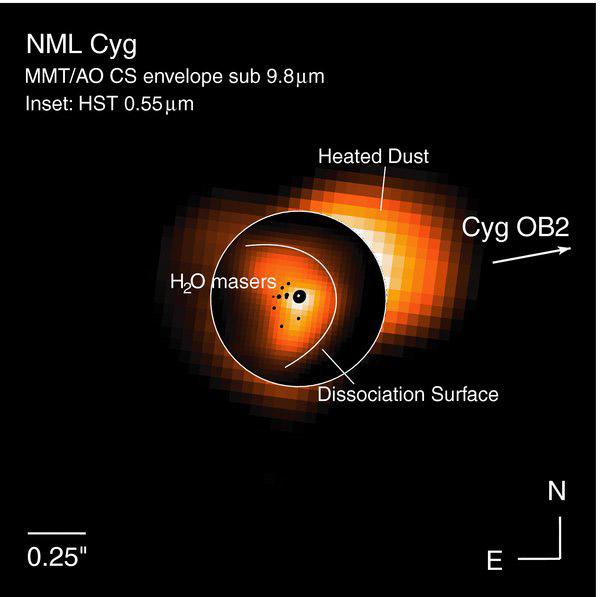
A composite image of the region around the bright infrared star NML Cygnus. Astronomers have used new technologies to obtain this precise image of the heated dust cloud. The star is the white dot at the center of the picture; the label "Heated Dust" refers to material blown from the star but heated by other, nearby stars.
One of the brightest stars in our galaxy is the aging, cool giant star NML Cygnus. It has a relatively enormous mass -- about forty times that of the sun -- and a luminosity nearly a million times larger than the sun's; it is also only about 5000 light-years away. NML Cygnus is surrounded by a thick cloud of dust, however, and so it is very faint in the visible. The dust, a product of the star's substantial wind (it loses about 20 earth-masses every year), radiates copiously at the infrared wavelengths, where the extreme nature of this star was first discovered.
Although astronomers have a good understanding of older, massive stars like NML Cygnus, this one has several other peculiarities that seem to stretch (if not challenge) the paradigm: it is associated with a huge cloud of ionized gas, for example, and the scattered light around the star is curiously elongated in shape.
SAO astronomers Mike Schuster, Massimo Marengo, Joe Hora, and Giovanni Fazio, along with five colleagues, used a relatively new infrared technique to image the dusty envelope and resolve the puzzle about its strange shape. The scientists used the MMT telescope coupled with an innovative new infrared camera device that senses and corrects for atmospheric distortions, thus allowing the camera to obtain some of the highest resolution pictures ever taken at these wavelengths.
The pictures show that the hot dusty envelope is entirely skewed to one side of the star. NML Cygnus is part of a very large cluster with hot stars that are only about 100 light-years away from it. The team had previously predicted that the ultraviolet light from these hot stars could be responsible for the ionized gas near NML Cygnus, and even heat up a circumstellar dust cloud so that it glowed only on the side nearest the hot stars. The new measurements confirm that prediction, and help to explain the bright, asymmetric shaped material near this massive star as being the result of its environment as well as of its own wind and physical properties.